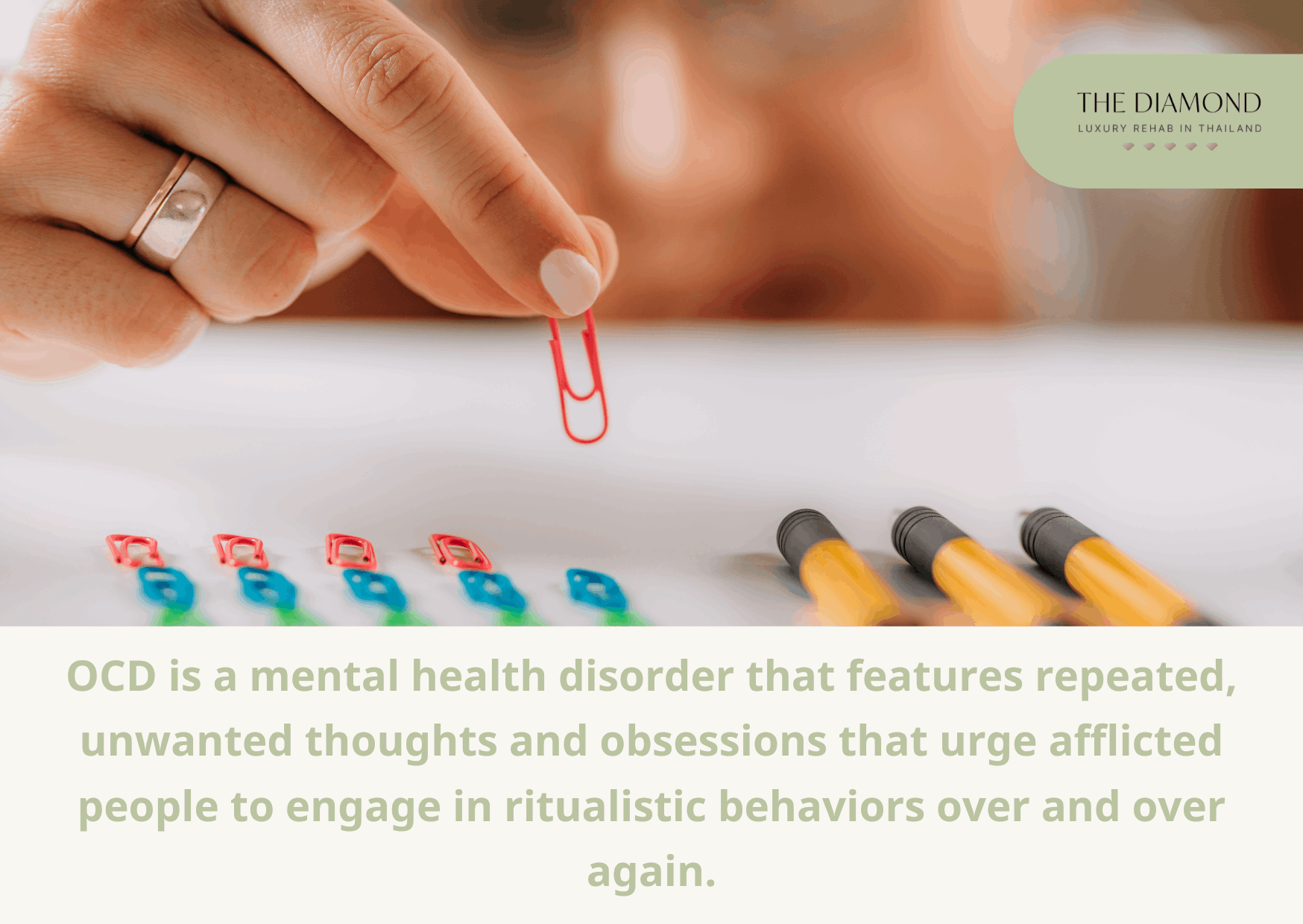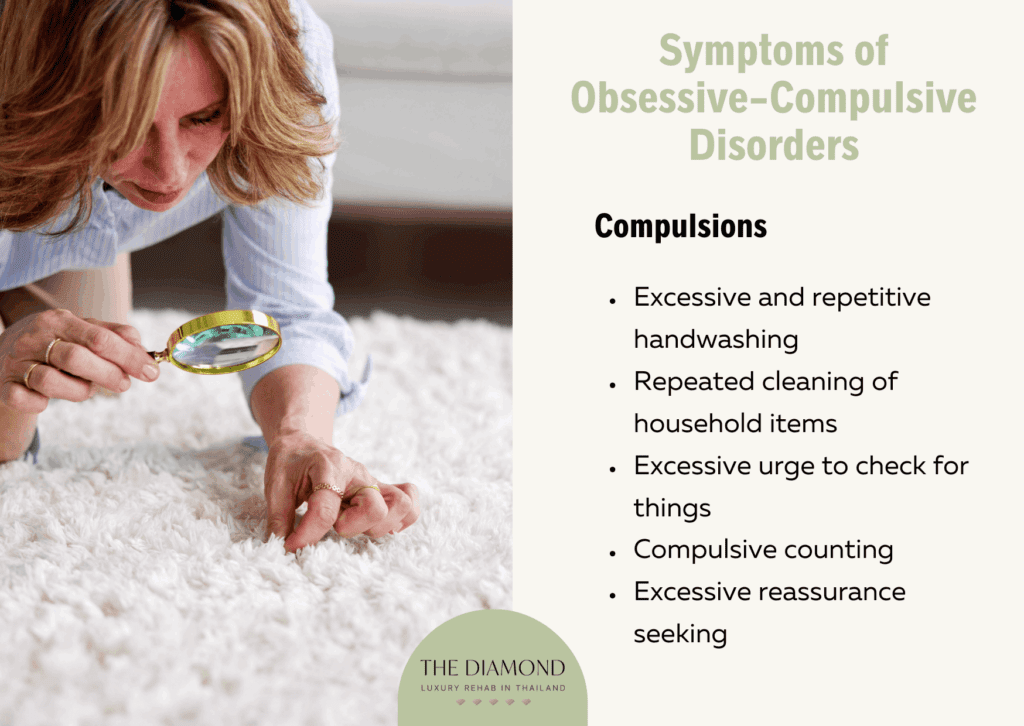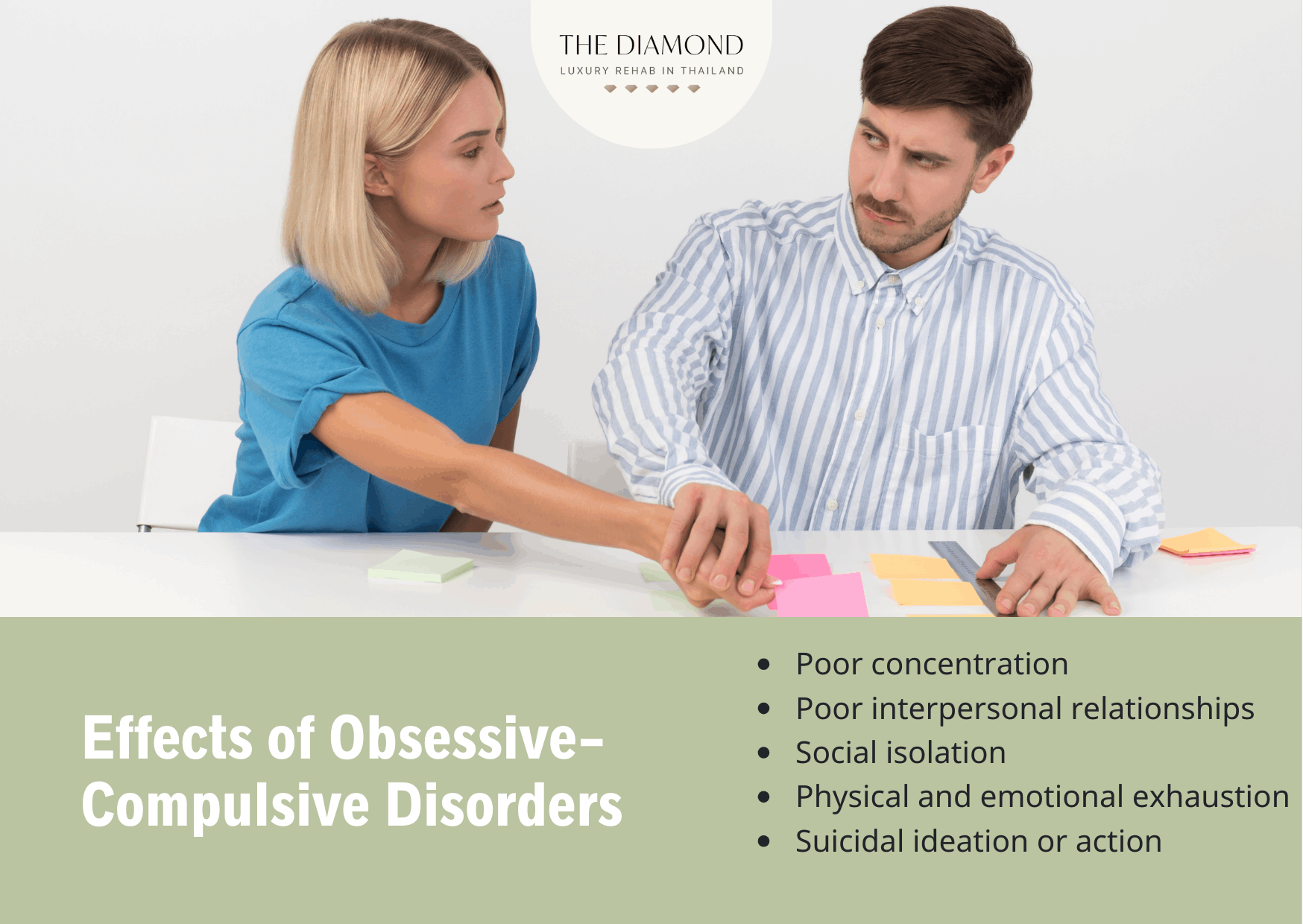Obsessive-compulsive disorder: symptoms, types, and treatments

Obsessive-compulsive disorder (OCD) is a mental health disorder that features repeated, unwanted thoughts and sensations (obsessions) that urge afflicted people to engage in ritualistic behaviors (compulsions) over and over again. These obsessive thoughts and urges can quickly interfere with one’s daily functioning.
The symptoms of OCD may include obsessions, compulsions, or both. Examples of OCD obsessions include fear around dirt or germs, unwanted blasphemous thoughts and images, as well as an extreme need for symmetry or exactness. On the other hand, common compulsions in OCD include excessive and repetitive handwashing, repeated cleaning of household items, and an excessive urge to check for things.
The types of OCD include organization, contamination, intrusive thoughts, ruminations, and checking.
Treatment options for obsessive-compulsive disorder include psychotherapy, medications, and deep brain stimulation (DBS).

What is Obsessive-compulsive disorder?
According to The National Health Service (NHS) website, obsessive-compulsive disorder (OCD) is a common mental health condition in which a person has obsessive thoughts and compulsive behaviors.
Individuals with OCD have frequent unreasonable thoughts or worries called obsessions. As a result, they turn to certain rituals or behaviors called compulsions in an attempt to eliminate intrusive thoughts. They also feel compelled to perform compulsive behaviors to gain relief from anxiety.
However, any relief that the compulsions may provide is only temporary and short-lived and leads to the obsessions coming back, which then traps the person in an endless loop of reciprocal rituals and distressing thoughts.
What are the causes of Obsessive-compulsive disorders?
The exact reason why people develop OCD is still poorly understood. However, experts speculate that certain factors or events may trigger or exacerbate the condition. The potential causes of obsessive-compulsive disorder are listed below:
- Genetics: Although there is evidence that obsessive-compulsive disorders have a genetic basis, it is still unclear which genes increase one’s risk of developing the condition.
- Brain structural and functional abnormalities: The frontal regions of the brain, such as the orbitofrontal and anterior cingulate cortices, as well as the basal ganglia and thalamus are mainly involved in the development of OCD, according to a study published in The Journal of Neuropsychiatry and Clinical Neurosciences. These areas of the brain have far more activity in people with obsessive-compulsive disorder.
- Painful childhood experience: A 2020 study published in the European Journal of Psychotraumatology suggests a close link between childhood trauma and OCD, with the strongest association found for emotional abuse. Although trauma, abuse, or bullying in childhood do not directly cause OCD to develop, these painful experiences may trigger the condition in someone who is already predisposed to it.
- Maladaptive parenting: A 2010 study published in the Journal of Cognitive Psychotherapy suggests that parenting style and family environment may precipitate the onset of OCD. In particular, parenting styles that involve overprotection and rejection can cause a child to use obsessions and compulsions as a way of coping with their anxiety. OCD behaviors can also be learned from watching family members display similar anxieties.
- Ongoing stress: Stress doesn’t directly cause OCD. However, being under constant stress may trigger or worsen symptoms in people who are genetically predisposed to OCD.
What are the symptoms of Obsessive-compulsive disorders?
People who are diagnosed with OCD may experience obsessions, compulsions, or both. The manifestations of the disorder can interfere with one’s daily functioning. The symptoms of obsessive-compulsive disorder are listed below.

Obsessions
- Fear around dirt or germs: Fears around illness, dirt, or germs is called contamination OCD, a common form of the disorder. Patients can spend hours dwelling on these fears and taking steps to avoid them on a daily basis. Over time, they may find themselves stuck in a cycle of excessive cleaning and washing rituals, ultimately affecting their quality of life.
- Unwanted blasphemous thoughts and images: Also known as religious OCD, those who suffer from the condition have obsessions with moral or religious connotations. For instance, they may fear some religious consequences if they didn’t say a prayer correctly. Blasphemous thoughts may or may not have accompanying compulsions.
- Extreme need for symmetry or exactness: Some people with OCD have strong urges to position objects in a symmetrical or perfect manner. They may feel uncomfortable and distressed when they see things that are not correctly aligned.
- Intrusive thoughts about harm: involves the fear of accidentally or intentionally hurting yourself or others. When thoughts of committing violent acts pop up in the mind of an OCD sufferer, they may act as if they are in real danger. As a result, they exert effort to make sure they are out of danger’s way by avoiding sharp objects or asking others for reassurance that such an event wouldn’t take place.
- Difficulty tolerating uncertain situations: A person with OCD has more doubt and uncertainty than what is helpful. They may become fixated on a certain thing and feel the need to make absolutely sure that it is okay. For instance, one could have obsessive doubts about whether the dishes have been cleaned. As a result, you check them and confirm that they have been washed. However, even after confirming, they start doubting their memory of having checked the dishes or begin doubting if they have washed them properly.

Compulsions
- Excessive and repetitive handwashing: Compulsive handwashing is performed in response to severe distress associated with an extreme and irrational fear of germs.
- Repeated cleaning of household items: also related to fears of contamination. Compulsive cleaners spend hours every day cleaning the same household objects several times, often with aggressive cleaning products like bleach. It is their way of easing feelings of impurity, but the ritualized activity actually offers only temporary relief.
- Excessive urge to check for things: Those who suffer from OCD may feel the urge to double-check things, such as stoves, locks, or switches. They respond to this obsessive concern by checking rituals to gain certainty that they will not cause something terrible to happen to themselves or others.
- Compulsive counting: One of the symptoms of OCD, wherein individuals have a strong need to count how many times they perform a specific action or count objects around them. This constant counting may be done mentally or out loud.
- Excessive reassurance seeking: a compulsive act done in an attempt to reduce the anxiety that is rooted from an obsession. If you have reassurance-seeking behaviors, you may engage in self-talk to reassure yourself or have someone as a source of reassurance and get them to tell you that things are going to be just fine.
How are Obsessive-compulsive disorders classified?
Obsessive-compulsive disorders are classified according to similarities in the obsessive thoughts and compulsive actions a person engages in to cope with them. Although symptoms may vary from person to person and may also evolve over time, there are symptom categories under OCD that can be described as its “forms.”
There are five most common types of obsessive-compulsive disorders, namely organization, contamination, intrusive thoughts, ruminations, and checking. Each category can cause disruptions in different areas of a person’s life.
What are the common types of Obsessive-compulsive disorders?

The most common types of obsessive-compulsive disorders are listed below.
- Organization: One of the most recognizable types of obsessive-compulsive disorder, which involves preoccupations with order and exactness and leads to a person performing compulsions, such as repetitive arranging or lining up of objects.
- Contamination: Another common OCD subtype where an individual obsesses over becoming contaminated by germs and getting sick as a result. These thoughts can cause intensely distressing feelings, which an OCD sufferer tries to relieve by excessively washing their hands or avoiding crowded places.
- Intrusive thoughts: are unwanted thoughts, impulses, or images that can occur randomly or can also be triggered by internal/external stimuli. These thoughts can often cause serious distress and tend to recur, with common themes being violence, religion, sexual behaviors, and causing accidents.
- Ruminations: a mental compulsion and one of the core features of OCD. The thoughts that get stuck in someone’s head in rumination-based OCD are not necessarily distressing. The ideas or situations can be religious or philosophical, but they repeatedly think about the same thoughts over and over without being able to stop or move on.
- Checking: involves checking compulsions and rituals that are done out of fear of causing something terrifying to happen if the action is not completed. They can be in the form of double-checking whether doors are locked or driving around a certain spot numerous times to see if they hit someone while driving.
How common are Obsessive-compulsive disorders?
Statistics show that between 1.1% and 1.8% of the world’s population has OCD. Within the United States, at least 1 in 200 kids and teens struggle with the condition, as stated by Cross River Therapy.
According to data from Harvard Medical School’s National Comorbidity Survey Replication (NCS-R), the lifetime prevalence of obsessive-compulsive disorders among U.S. adults was 2.3%, with rates higher in women (1.8%) than in men (0.5%).
A 2021 study published in The Journal of Nervous and Mental Disease indicated that it is widely agreed that the onset of OCD compulsions and/or obsessions among elderly people is unusual. In fact, only 0.7% of adults over 60 are estimated to meet the DSM-IV criteria for OCD. A 2020 case report published in Frontiers in Psychiatry also stated that OCD cases after the age of 50 are most likely associated with inflammatory, brain lesions, or neurodegenerative comorbidities.
How are Obsessive-compulsive disorders diagnosed?
Obsessive-compulsive disorders are diagnosed by using a psychological assessment with the help of the diagnostic criteria for OCD in the Diagnostic and Statistical Manual of Mental Disorders (DSM-5) or through a physical exam.
Mental health professionals often conduct a psychological assessment using a structured interview where they will ask questions about your thoughts, feelings, and symptoms, and check if they are all consistent with the diagnostic criteria for OCD as stated in the American Psychological Association’s psychiatry text, DSM-5.
A physical exam may also be done in order to rule out other underlying medical conditions that could be causing your symptoms.
What are the treatments for Obsessive-compulsive disorders?

Obsessive-compulsive disorder treatment can significantly improve one’s quality of life and daily functioning, including their ability to function at work, home, or school, and the ability to maintain lasting relationships. The treatments for obsessive-compulsive disorders are listed below.
1. Deep brain stimulation (DBS)
Deep brain stimulation (DBS) is mainly used for patients who do not respond well to first-line OCD treatments such as medications and psychotherapy. It works by sending electrical signals to the region of the brain known as the ventral capsule/ventral striatum, which is thought to be responsible for the development of the disease OCD. Changes induced by DBS correlate with a significant reduction in OCD symptoms.
2. Cognitive behavioral therapy
Cognitive behavioral therapy (CBT) is a form of psychotherapy that is widely used in a plethora of mental health conditions, including OCD. CBT operates on the idea that our thoughts, emotions, and behaviors are all connected. Therefore, changing the way we think and feel by replacing negative thoughts with positive ones will also cause a significant change in how we act. Exposure and response prevention (ERP) is a component of CBT that is often used for patients with obsessive-compulsive disorder. It involves deliberately putting the patient in a situation that would usually make them uncomfortable or anxious, only this time, the therapist stops them from responding with a compulsion and instead encourages them to try to tolerate the anxiety. This helps someone with obsessive-compulsive disorder confront their obsessions and resist the urge to compulsively act on them.
3. Medications
Medications such as serotonin reuptake inhibitors (SRIs), selective SRIs (SSRIs), and some tricyclic antidepressants are effective in managing the signs of OCD. These antidepressants are helpful for people with OCD due to their effect in altering the balance of chemicals in the brain. This way, these medications reduce the severity of OCD symptoms. A combination of CBT and medications is considered the best treatment for those whose symptoms are severe.
What are the effects of Obsessive-compulsive disorders when left untreated?

Untreated OCD can cause significant harm to your mental and physical well-being. The effects of obsessive-compulsive disorder when left untreated are listed below:
- Poor concentration: Obsessive thoughts can cause a person to spend hours engaged in unnecessary, time-consuming activities to ease their anxiety. In the long run, this can make it difficult or even impossible for them to concentrate on certain routines or functions as a result of spending a great deal of time on their obsessions and compulsions.
- Poor interpersonal relationships: OCD sufferers may struggle with feelings of shame, embarrassment, and low self-esteem, which could lead to a lack of interest in being around family, friends, and other people.
- Social isolation: Someone with the disorder may try so hard to avoid triggers that they cut themselves off from the world and avoid going outside. This can cause social isolation, which could then lead to severe depression or other psychological disorders.
- Physical and emotional exhaustion: The symptoms of OCD can be emotionally and physically draining. Long-term stress brought on by intrusive thoughts and images can be mentally exhausting, while responding with repetitive activities to gain relief from anxiety can also be physically tiring.
- Suicidal ideation or action: The burden of having your entire life revolve around acting on OCD obsessions and compulsions can be devastating and may lead a patient to develop suicidal thoughts or, even worse, act on them. Without proper treatment for obsessive -compulsive disorder, the uncontrollable condition can rule your daily life and may feel like a roadblock.
Is it possible to prevent Obsessive-compulsive disorders?
No, there is no way to prevent obsessive-compulsive disorders. The exact cause of OCD is still poorly understood, and our overall understanding of the condition is primitive.
However, if you have OCD, you can take steps to prevent it from disrupting your daily life. This is where the importance of seeing early treatment comes in – early diagnosis and intervention for OCD can minimize the severity of your symptoms and help you regain significant control over your life.

